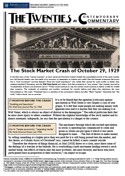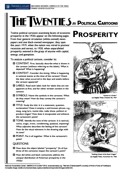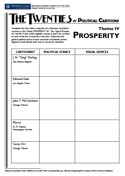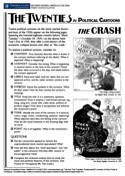PROSPERITY
4. Crash
- Collected commentary on the 1929 stock market crash, 1928-1938 PDF
- Political cartoons on stock speculation and the crash, 1928-1929 (12) PDF
- Cartoonist analysis chart PDF



There are pivotal moments in history. Volcanoes explode, droughts end, dictators die, enemies invade, revolutions succeed, economies collapse. For the United States, despite its recurring financial panics, "economic collapse" did not join its list of pivotal moments until the stock market crash of 1929. It can be argued that the pivotal moment was not October 29—"Black Tuesday"—but some instant later when the nation as a whole realized the economy was not going to bounce back, prosperity had left the scene, and a bleak new reality had arrived: "depression." Here we examine commentary and political cartoons that illustrate this pivotal moment in American history.
Note: Financial terms are briefly explained in footnotes. For elaboration, see Supplemental Sites below.
Collected commentary. As many starstruck first-time investors fueled the unparalleled growth of the stock market in the 1920s, how did financial leaders view the health of an economy so dependent on dreams and credit? Had the frenzied investment fad grown into a "mob movement" courting disaster? Were the "small speculators" who risked their savings for quick profits no better than weekend gamblers? Nonsense, said the Wall Street Journal and others. Such fear-mongering is "sour grapes," they insisted, spurred by "propagandists of gloom and economic terror." Prices would continue to rise; the market would continue to deliver profits for middle class investors. The onslaught of prediction and punditry continued for months before—and after—the calamitous day soon immortalized as "the crash." Presented here is a sampling of the commentary before and after "Black Tuesday," illustrating that "the crash," while a shock, was no surprise. Selections can be divided among students for research and classroom discussion. (11 pp.)
Political cartoons. Twelve political cartoons spanning the frenzied eighteen months before "Black Tuesday" to the dismal New Year's Eve of 1929, offer a mini-history of the greatest economic collapse in U.S. history. Did the cartoonists applaud or lament the unprecedented stock market speculation that preceded the crash? How did they depict the tumultuous response after the crash? Complete the cartoonist analysis chart to study the visual and symbolic features of the cartoons. (13 pp.)
See also "Age of Prosperity," Business, and Consumerism.
Discussion Questions
- Why did some observers of the stock market boom, including Alan Temple, Roger Babson, and cartoonist "Ding" Darling, warn of a coming crash?
- Why did others, including John Raskob, Irving Fisher, Charles Dice, and the Wall Street Journal, dismiss such warnings?
- Describe the variety of editorial responses in the nation's newspapers on October 30, 1929, the day after "Black Tuesday." Who and what was to blame? What was the nation to do?
- Why was the 1929 crash described as a "new kind of panic"? How did it differ from the panics of 1907, 1901, 1896, and earlier years? (See Supplemental Sites below.)
- Study the variety of phrases coined to describe the unique nature and severity of the crash, such as "the prosperity panic of 1929" and "a stock market hurricane." What do they illustrate about the nation's response to the crash?
- Why did some financial analysts believe the crash would not fundamentally disturb national prosperity?
- What role did President Hoover assume during the financial crisis? What was expected of him as chief executive?
- Why was the Federal Reserve System blamed by some and praised by others for its role in the stock market boom and crash?
- How did analysts judge the banking system? the "small speculator"? What other factors were singled out as contributors to the crash?
- According to two commentators, how did the stock market boom fit the "American temperament"—its historic "pioneer spirit"?
- In what way was the commentary by journalist Frederick Lewis Allen, written two years after the crash, an elegy for the lost optimism of the 1920s?
- What did lawyer Barnie Winkelman mean by the "magic of red ink" in his study Ten Years on Wall Street, published three years after the crash? What changes in national attitude were apparent by 1932?
- Did the cartoonists applaud or lament the unprecedented stock market speculation that preceded the crash?
- How did they depict the tumultuous response after the crash?
- Complete the cartoonist analysis chart to analyze their viewpoints and the visual devices they used to convey them.
- How is the "small speculator" depicted in the cartoons? Is he wise or foolish? informed or gullible?
- How did the cartoonists use the common symbols of Uncle Sam, the bull and the bear (markets), the wealthy man with cigar and top hat, and the bankrupt man wearing a wooden barrel? What common symbols appear in political cartoons today?
- How did the cartoonists use recent news events unrelated to the stock market as central symbols in their cartoons, as in "Another Record for Sustained Flight" and "This Way Out"?
- Consider cartoonists' selection of objects to serve as symbols. For example, in "Halted!" why might Holleran have depicted a horse-drawn carriage instead of an automobile? In "Amateur Night," why did Darling not depict standard jugglers' fare like plates, balls, etc.? In "Somebody Had to Save Him from Himself," why did Gale not depict Uncle Sam drinking too much beer instead of eating too much food?
- Check the political cartoons for details, often unlabeled, that one might miss on first view. What does each add to the cartoon's meaning? Add examples to the chart below.
Cartoons Details Des Moines Register, Nov. 24, 1928 aghast audience members Washington Post, Jan. 4, 1929 robot-like pilot as ticker tape machine
dollar-sign drops of gasolineLos Angeles Times, Oct. 18, 1929 lamb's tear drop Atlanta Constitution, Oct. 31, 1929 astonished emergency medics Atlanta Constitution, Nov. 17, 1929 speculator's black eye
horse's broken reinsLos Angeles Times, Dec. 31, 1929 earth as the dwelling awaiting a new resident - Drawing evidence from the commentary and cartoons in this section, write an overview of the 1929 stock market crash. Include the preceding years of stock speculation and the post-crash inquiry into causes and consequences. Begin or end your summary with one of these statements:
- —"It's fine as long as you're going up." Jay N. "Ding" Darling, political cartoon, Des Moines Register, March 29, 1928
- —"Fair weather cannot continue. . . . Sooner or later a crash is coming and it may be terrific." Roger Babson, businessman and investment analyst, address, July 1928
- —"Don't you know when you've had enough?" Waiter in cartoon by Edmund Gale, Los Angeles Times, Feb. 8, 1929
- —"It is clear that the Street is going through the greatest disaster in its history. No fair words can gloss over that fact." New York Evening Post, Oct. 30, 1929
- —"[T]he country will be better off for the lesson it has had, costly though it be." Nashville [Tennessee] Banner, Oct. 30, 1929
- —"Never again—until the next one comes along." Jay N. "Ding" Darling, political cartoon, Des Moines Register, Nov. 8, 1929
- —"Oh it was a great game while it lasted." Will Rogers, syndicated column, Nov. 24, 1929
- —"Is the country headed for calamity, with the stock market carrying the flag?" The Nation, Nov. 27, 1929
- —"It is impossible to grasp the change in life and thought produced by the economic upheaval." Barnie Winkelman, Ten Years of Wall Street, 1932
- —"On that day of October 29, they told me I needed more cash to cover up. I couldn't get it. I was wiped out that day." George Mehales, WPA Life Histories interview, December 1938
- —"It's fine as long as you're going up."
Framing Questions
- What factors nurtured or weakened the unprecedented prosperity of the 1920s?
- How did "prosperity" become a hallmark of national pride? How was the word adapted for political and psychological aspirations of the nation?
- What role did "workingmen" and labor unions play in the economic panorama of the period?
- Compare the Twenties' boom-and-bust with similar economic cycles before and after the decade.
Printing
CommentaryPolitical cartoons
Cartoonist analysis chart
TOTAL
11 pp.
13 pp.
1 p.
25 pp.
Supplemental Sites
- - Wall Street Crash of 1929
- - List of recessions in the United States
- - Economic disasters in the United States (with links to individual panics)
- - Federal Reserve System
- - Short selling
- - Stop-loss order (stop order)
- - Curb trading (on the curb)
- - Florida land boom of the 1920s
Learn the Stock Market (Stock Market Watch; BlueWave Advisors, LLC)
Primary sources in History Matters (George Mason University and the City University of New York)
- - "Oh Yeah?": Herbert Hoover predicts prosperity [after the crash], 1929
- - "The Gigantic Forces of Depression Are Today in Retreat": Hoover Insists That Things Are Getting Better, 1932 campaign speech, audio
Federal Reserve System: Education Resources
Timeline: A Year of Financial Crisis—2008 (NPR)
Analyzing political cartoons: guides from
- - Library of Congress
- - Library of Congress (lesson plan)
- - National Archives
- - National History Education Clearinghouse
Images:
– "Wall Street Lays an Egg," Variety, October 30, 1929, front page. Reproduced by permission of Variety; © 1929 Reed Business Information, a division of Reed Elsevier, Inc.
– James N. Rosenberg, Oct 29 Dies Irae, lithograph, 1929 (detail). Search in process for current agent for the estate of James Rosenberg; digital image courtesy of the Library of Congress, Prints & Photographs Division, LC-DIG-ppmsc-00816.
– News articles, The New York Times (details): (1) "Realty Man Missing after Stock Crash," Oct. 26, 1929; (2) "Falls Dead at Ticker as Stocks Decline," Oct. 30, 1929. Permission request in process; digital images courtesy of ProQuest Historical Newspapers.
– Jay N. "Ding" Darling, "Never Again—Until the Next One Comes Along," political cartoon, Des Moines Register, November 8, 1929. Reproduced by permission of the Jay N. "Ding" Darling Wildlife Society; digital image courtesy of the University of Iowa Libraries.
– Edmund Gale, "This Way Out!" political cartoon, Los Angeles Times, December 31, 1929. Reproduced by permission of the Los Angeles Times; digital image courtesy of ProQuest Historical Newspapers.
*PDF file - You will need software on your computer that allows you to read and print Portable Document Format (PDF) files, such as Adobe Acrobat Reader. If you do not have this software, you may download it FREE from Adobe's Web site.




